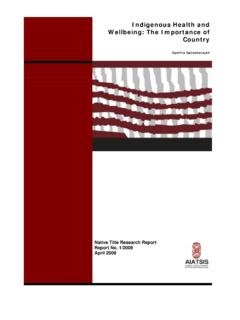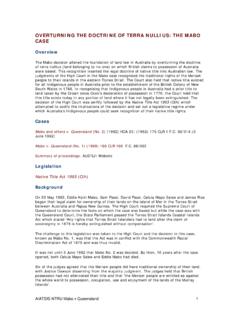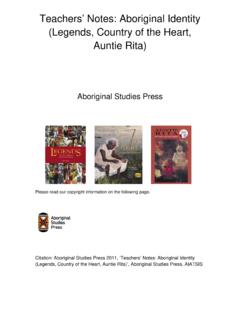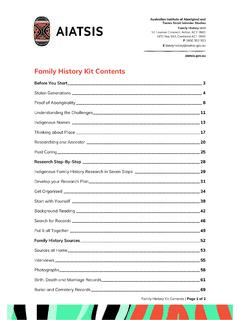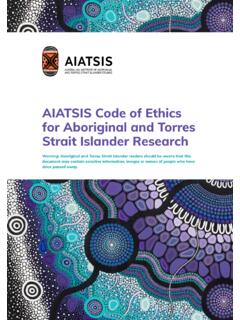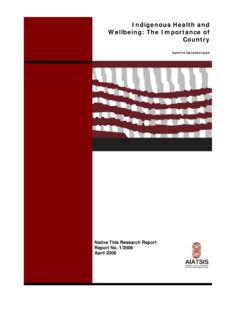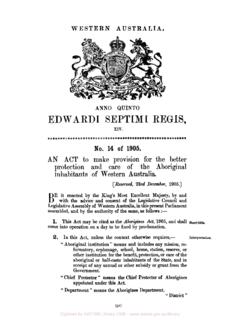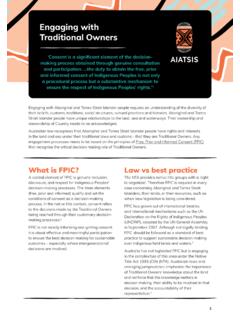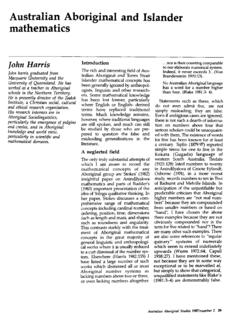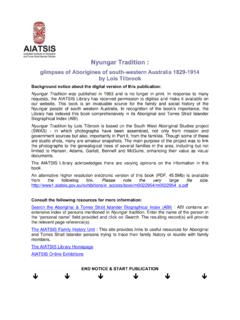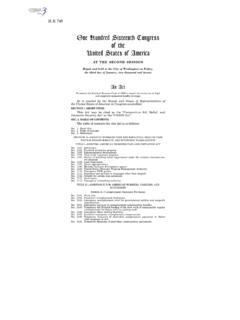Transcription of The policy of assimilation : decisions of Commonwealth and ...
1 THE policy . of assimilation . decisions of Commonwealth and State Ministers at the Native Welfare Conference, Canberra, January 26th and 27th, 1961. Digitised by AIATSIS Library A conference of Commonwealth and State Ministers was held at Canberra on 26th and 27th January, 1961, to consider the advance- ment of the welfare of Australian aborigines. The following Ministers attended: Common wealth: The Hon. P. Hasluck, , Minister of State for Territories (Chairman). The Hon. H. S. Roberton, , Minister of State for Social Services. New South Wales: The Hon P. Hills, , Secretary and Minister for Local Government. Victoria: The Hon. Murray V. Porter, , Minister for Local Government. Queensland: The Hon. H. W. Noble, , , , Minister for Health and Home Affairs. South Australia: The Hon. G.
2 G. Pearson, , Minister of Works. Western Australia: The Hon. C. C. Perkins, , Minister for Native Affairs. Tasmania: The Chief Secretary of Tasmania, Hon. J. E. Gaha, , was represented by Mr. G. C. Smith, Director of Social Services. The results of the conference were announced in the Common- wealth Parliament by the Minister for Territories in a statement by leave on Thursday, 20th April, 1961. Digitised by AIATSIS Library NATIVE WELFARE CONFERENCE. Statement by leave by the Minister for Territories {the HON. PAUL HASLUCK, ) in the House of Representatives on Thursday, 20th April, 1961. For the information of members and for the completeness of the record, I wish to present to the House an outline of the work of the Native Welfare Conference held at Parliament House, Canberra, on 26th and 27th January last.}
3 This was a conference of Federal and State Ministers responsible for native welfare and the agenda was formed of items relating to matters which Governments handle in respect of the advancement of native welfare. In keeping with the custom of Federal-State ministerial conferences each participating Minister is reporting the results to his own government and the responsibility will rest on each government to make decisions on matters which fall within its constitutional powers. The conference agreed on the following statement of the meaning of the policy of assimilation , to which all Australian governments adhere, and on methods of advancing that policy . THE policy OF assimilation . (a) MEANING OF policy . The policy of assimilation means in the view of all Australian governments that all aborigines and part-aborigines are expected eventually to attain the same manner of living as other Australians and to live as members of a single Australian community enjoying the same rights and privileges, accepting the same responsibilities, observ- ing the same customs and influenced by the same beliefs, hopes and loyalties as other Australians.
4 Thus, any special measures taken for aborigines and part-aborigines are regarded as temporary measures not based on colour but intended to meet their need for special care and assistance to protect them from any ill effects of sudden change and to assist them to make the transition from one stage to another in such a way as will be favourable to their future social, economic and political advancement. 3377/61. 2. Digitised by AIATSIS Library 2. In making this statement attention should be drawn to the rather loose use of the term " citizenship " when aborigines are said to have achieved " citizenship " by being exempted from the provisions of special state and territory statutes which apply only to aborigines. In some respects, the position is somewhat like that of a minor who is basically a citizen but who, because he is under the age of 21 years, may not be able to do everything that other inhabitants of Australia may be able to do, and may be protected and assisted in ways in which the adult is not protected and assisted.
5 In our view, Australian aborigines are Australian citizens by virtue of the Nationality and Citizenship Act 1948-1960. The special rights and disabilities which they have under state and territory statutes can in no sense derogate from citizenship in the sense of status as Australian citizens. In effect then, a person placed under the provision of State and Territorial Native Welfare Acts has certain restrictions placed on him in some states but that does not in any way take his Australian citizenship away from him, although it may limit for the time being his exercise of some of the rights enjoyed by other citizens and may afford him assistance not given to other citizens. (b) METHODS OF ADVANCING THE policy . Secondly, the conference gave attention to methods of advancing the policy .
6 They are: (i) Extension, where applicable, of government settlement work to encourage nomadic and semi-nomadic natives to adopt a more settled way of life and to make health services, better standards of housing and nutrition, schooling, voca- tional training and occupation available to them and their children, as a first stage towards their assimilation . (ii) Provision of health services including particularly child welfare services. (iii) Provision of education in normal schools and pre-schools to the extent possible otherwise in special schools and pre- schools for all aboriginal and part-aboriginal children. (iv) Continual improvement in housing and hygiene standards on government settlements, missions, rural properties, in towns and assistance towards provision of and training in the use of improved housing facilities particularly in town areas.
7 (v) Vocational training (including apprenticeship) and employ- ment, particularly in ways which will assist aborigines and part-aborigines to make a contribution to the advancement Digitised by AIATSIS Library 3. of their own people by employment teaching assistants, nursing and medical assistants, patrol officers, welfare officers, and so on. (vi) Encouragement of social and sporting activity both among aborigines and part-aborigines and participation by them in general community activity. (vii) Extension of welfare work, particularly to assist those people living in or near towns to adjust themselves to the life of the community. (viii) Welfare services provided for other members of the com- munity to be available to aborigines and part-aborigines, for example, child, family and social welfare services.
8 (ix) A liberal approach to the removal of restrictive or protective legislation as soon as the capacity and advancement of the individual makes this possible. (x) Positive steps to ensure awareness in the general Australian community that implementation of the policy of assimila- tion is not possible unless advanced aborigines and part- aborigines are received into the community and accepted without prejudice, and to ensure, as far as possible, that the Australian community plays its full part in this programme. (xi) Further research into special problems associated with the native welfare programme. It is recognized that some of these methods may not be applicable in every State of the Commonwealth and that methods may vary from State to State. For example, in a State such as Victoria the need for all of those methods may not arise although in an area such as the Northern territory we will wish to use every one of them, because every one of them is necessary.
9 I am sure the House will appreciate the point that the conditions of people of aboriginal race vary very greatly from place to place in Australia, but the methods, the list of which I have read to honorable members, are the methods which the conference of Ministers agreed would best serve advancement of the policy of assimilation . (c) FURTHER MEASURES REQUIRED TO BE TAKEN EITHER SEVERALLY. OR IN CO-OPERATION TO ADVANCE THE policy . The conference also gave attention to methods of advancing this policy , to be taken either severally or in co-operation. Digitised by AIATSIS Library 4. The conference agreed that, apart from measures covered by other items on the agenda, particular attention needs to be given to the following: (i) Housing: Notwithstanding the considerable progress that has been made, shortage of sufficient houses for abori- gines and part-aborigines ready to accept employment opportunities which would enable them to take their place in the community is a major factor militating against assimilation .
10 Special attention needs to be given to increasing facilities and resources in order to meet this general problem. (ii) Transitional Housing: It is believed that in some states there is a need for transitional housing for aborigines and part-aborigines who are able to accept award em- ployment but require further guidance in home manage- ment before they can manage a normal home. Such houses may be simple in construction and established quite cheaply but should conform with local government minimum building standards. (iii) Supervision by Welfare Staff: In all phases of assimilation welfare workers must be available to assist the people in making the necessary adjustments. Personal contact and guidance must be continually available to each individual and family. In some states an increase in the number of welfare workers is necessary.
